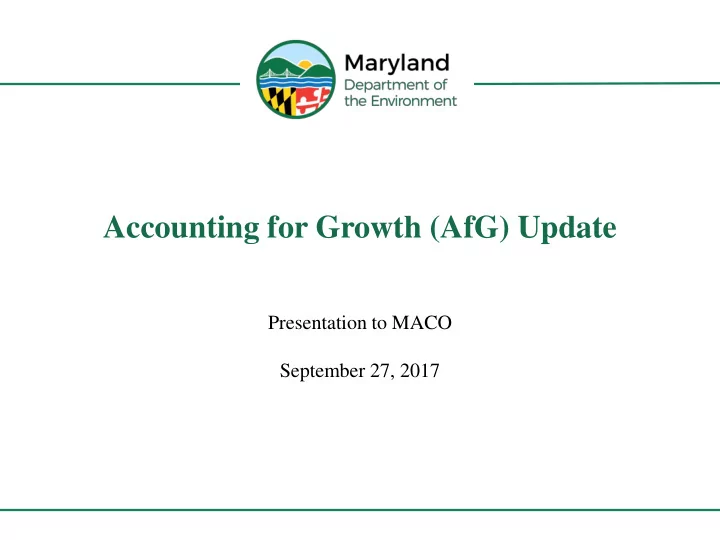

Accounting for Growth (AfG) Update Presentation to MACO September 27, 2017
Why an AfG Policy? EPA requires states to provide “certainty that increased nutrient and 1. sediment loads resulting from growth have been accounted for and will be fully offset up to and through 2025”. * 2. There is currently no Bay TMDL allocation for new growth. 3. Growth contributes new loads to the urban sector. *See https://www.epa.gov/sites/production/files/2017- 02/documents/interim_phiii_wip_expectations_1.19.17.pdf
Maryland Historic Growth Trends Scenario Results (2013-2025) 66% on 500,000 413,789 WWTP 248,547 400,000 300,000 200,000 100,000 0 New Housing Units New Jobs Source: USGS and MDP
AfG History 1. AfG policy approaches included in WIP 1 & 2 (2009/2010). 2. April 2011 Executive Order establishing Task Force on Sustainable Growth and Wastewater Disposal. Sustainable Growth and Agricultural Preservation Act of 2012 – 3. established Growth Tiers and provided authority for offsetting septics on major subdivisions in Tier 3 areas. 4. 2012 Draft AfG Policy that revealed lack of consensus on key issues. 5. 2013 AfG Policy Workgroup Report.
Historical Outcomes 1. Consensus on all but “loading baseline” and “trading geographies”. 2. Established foundational principles or objectives that any AfG program should be consistent with. 3. No official AfG policy established.
Current Status? 1. Reconvened State agency partners (MDE, MDP, MDNR, MDA) in Spring 2017 to restart AfG policy discussions. 2. Focused on consistency with AfG objectives and incorporating existing programmatic capacity to address growth. 3. Evaluating 2 policy options in terms of technical details and consistency with objectives. 4. Reaching out to stakeholders on policy approach.
Policy Option 1 : OSDS/Forest Conversion Offsets new On-Site Disposal Systems: Tier III only? Tier III & IV? All? Offsets increased Loads from new development on Forested lands: Offset = post-development load – forest load
Policy Option 2 : Lowest Per Capita Loading County-specific loading maps that factor in existing programs and local zoning effectiveness in producing lowest loads. Offsets loads exceeding county-specific lowest per capita loading rate
Next Steps • Solicit Preliminary Stakeholder Feedback/Suggestions • Develop a detailed timeline backing up from the December 2018 Draft Near Phase 3 WIP. • Flesh Out Policy Options and Related Technical Analyses in Consideration of Input Received Mid • Stakeholder Check-In • Provide an AfG policy recommendation for Bay Cabinet Approval. • Include AfG Policy in December 2018 Draft phase 3 WIP Long
Matthew C. Rowe Assistant Director, Water and Science Administration matthew.rowe@maryland.gov 410-537-3578
Recommend
More recommend